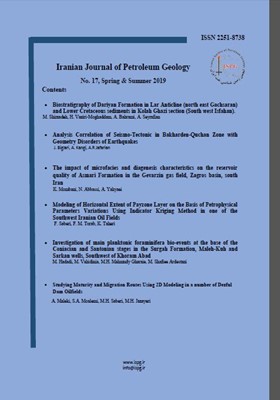Studying Maturity and Migration Routes Using Two-Dimensional Modeling in a number of Dezful Dam Oilfields
Subject Areas : Petroleum GeologyAshkan Maleki 1 , Seyed Ali Moallemi 2 , Mohammad Hossein Saberi 3 * , Mohammad Hassan Jazayeri 4
1 -
2 -
3 -
4 -
Keywords: One-dimensional modeling Two-dimensional modeling Dezful embayment Migration model,
Abstract :
To the southwest of Iran there are large reservoirs of oil and gas including Jurassic and Cretaceous carbonates, with good source rocks in the succession of the Early Cretaceous and Jurassic. The purpose of this study was to investigate the production, migration and characterization of Pabdeh, Kazhdumi, Garru and Serglu source rocks in the study area. For this purpose, burial history and one-dimensional thermal modeling in four wells and two-dimensional modeling in one section for the study area were evaluated using Openuploo software to determine the maturity of layers and hydrocarbon outflow. Comparison of measured vitrinite temperature and reflectance values with model results was used for model calibration. The results of one-dimensional modelling of the burial and thermal history in this study show that the Sergloo, Grove and Kazhdumi formations have reached maturity and have had hydrocarbon outflow, but the Pabdeh Formation has not reached sufficient maturity for hydrocarbon maturation and production. The results of migration model in the studied section show that the two Early Cretaceous and Middle Cretaceous hydrocarbon systems were separated by Kazhdumi Formation and therefore hydrocarbon migration in deeper layers of Kazhdumi was mostly lateral to Abadan plain. The hydrocarbon produced from the Kazhdumi Formation, in addition to ornithologically rearing the upper layers, migrated to the Ilam and Sarvak layers due to the general slope of the layers laterally and toward the Abadan plain. In general, the process of maturation of source rocks decreased from east to west of the study area.

